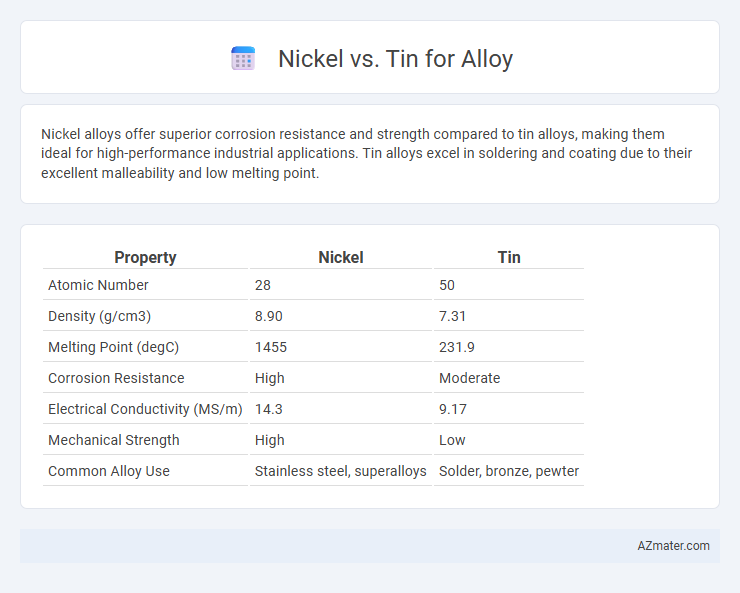Nickel alloys offer superior corrosion resistance and strength compared to tin alloys, making them ideal for high-performance industrial applications. Tin alloys excel in soldering and coating due to their excellent malleability and low melting point.
Table of Comparison
| Property | Nickel | Tin |
|---|---|---|
| Atomic Number | 28 | 50 |
| Density (g/cm3) | 8.90 | 7.31 |
| Melting Point (degC) | 1455 | 231.9 |
| Corrosion Resistance | High | Moderate |
| Electrical Conductivity (MS/m) | 14.3 | 9.17 |
| Mechanical Strength | High | Low |
| Common Alloy Use | Stainless steel, superalloys | Solder, bronze, pewter |
Introduction to Nickel and Tin Alloys
Nickel and tin alloys exhibit distinct properties that are crucial in various industrial applications, with nickel known for its excellent corrosion resistance, high strength, and thermal stability, making it ideal for aerospace and chemical processing industries. Tin alloys, often combined with metals like copper and lead, provide improved machinability, low melting points, and anti-corrosive qualities essential in soldering, plating, and bearing materials. Understanding the unique characteristics of nickel and tin alloys enables optimized material selection for enhanced durability, conductivity, and mechanical performance across diverse engineering fields.
Key Properties of Nickel in Alloy Production
Nickel enhances alloy production through its exceptional corrosion resistance, high tensile strength, and excellent thermal stability, making it ideal for demanding environments. It improves toughness and ductility, enabling alloys to maintain structural integrity under stress and varying temperatures. Nickel's magnetic properties and resistance to oxidation also contribute to alloy durability and performance in industrial applications.
Key Properties of Tin in Alloy Production
Tin in alloy production offers key properties such as excellent corrosion resistance, enhanced solderability, and improved ductility, making it ideal for creating durable and reliable metal formulations. Its low melting point facilitates easy alloying without compromising strength or malleability, often improving the overall mechanical properties of alloys. These characteristics make tin a crucial component in applications requiring protective coatings and electrical conductivity.
Comparative Strength and Durability
Nickel exhibits superior strength and durability compared to tin when used in alloys, providing enhanced corrosion resistance and mechanical stability. Alloys with nickel maintain structural integrity under high stress and extreme temperatures better than tin-based alloys, which are softer and more prone to deformation. The high tensile strength and hardness of nickel alloys make them preferable for demanding industrial applications, whereas tin alloys are favored for their malleability and ease of soldering.
Corrosion Resistance: Nickel vs Tin
Nickel exhibits superior corrosion resistance compared to tin, especially in harsh chemical environments and high-temperature applications. Nickel alloys provide enhanced protection against oxidation, acid, and saltwater corrosion, making them ideal for industrial and marine uses. Tin, while resistant to mild corrosion and commonly used as a protective coating on steel, offers less durability against aggressive chemicals and prolonged exposure to moisture.
Alloy Performance in Various Applications
Nickel alloys offer superior corrosion resistance, high strength, and excellent thermal stability, making them ideal for aerospace, chemical processing, and marine applications. Tin alloys provide good solderability, low toxicity, and cost-effectiveness, often used in electronics, plating, and food packaging industries. The choice between nickel and tin alloys depends on specific performance requirements such as mechanical strength, environmental resistance, and thermal conductivity.
Cost and Availability Considerations
Nickel generally commands a higher price than tin due to its extensive industrial applications and limited supply, making it a costlier component in alloys. Tin, being more abundant and less expensive, offers a budget-friendly alternative for alloy production, especially in large-scale manufacturing. Availability of nickel can be affected by geopolitical factors and mining challenges, while tin's relatively stable supply enhances its appeal for cost-sensitive alloy formulations.
Environmental Impact and Sustainability
Nickel demonstrates higher environmental impact due to energy-intensive mining and processing, contributing to habitat disruption and greenhouse gas emissions. Tin extraction tends to have lower carbon footprints but raises concerns about deforestation and water contamination in alluvial mining areas. Sustainable alloy production increasingly prioritizes recycled materials and stricter environmental regulations for both metals to reduce ecological damage.
Common Industrial Uses of Nickel and Tin Alloys
Nickel alloys are extensively used in aerospace, chemical processing, and marine industries due to their exceptional corrosion resistance, high strength, and ability to withstand extreme temperatures. Tin alloys, especially bronze and pewter, find common applications in electrical soldering, plating, and manufacturing of bearings and bushings, prized for their low friction and anti-corrosive properties. Both metals play critical roles in improving durability and performance across automotive, electronics, and construction sectors.
Choosing the Right Metal: Factors to Consider
Selecting the appropriate alloy metal depends on corrosion resistance, mechanical strength, and application environment, with nickel offering superior durability and resistance to oxidation compared to tin. Nickel alloys excel in high-temperature and chemically aggressive conditions, making them ideal for aerospace and industrial uses, while tin is preferred for its non-toxic properties and excellent solderability in electronics and food-safe coatings. Consider factors such as thermal conductivity, ductility, and cost-effectiveness when deciding between nickel and tin to ensure optimal performance and longevity in the final product.

Infographic: Nickel vs Tin for Alloy
 azmater.com
azmater.com